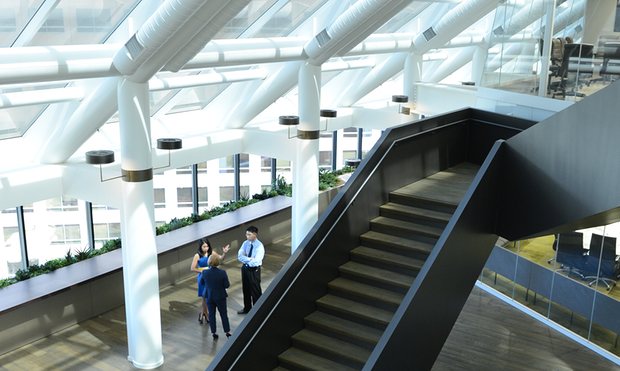
Already buzzing with energy as he is, the real estate wellness pioneer Paul Scialla takes it to another level when discussing how to lure office workers to the water cooler.
“If people see water, they drink water,” he says.
The former Goldman Sachs partner is outlining his plan as to how office space can be configured to improve the visibility of what he insists on referring to as “hydration stations”.
It is just one of hundreds of small touches the American entrepreneur has codified into the Well Building standard, an accreditation system that rates how a building affects the wellbeing of those within, just as the eco-conscious Green Star rating system assesses a structure’s impact on the environment outside.
Water is one of seven wellness categories Scialla wants real estate developers to consider in their building projects, along with air, light, nourishment, fitness, comfort and mind – a remit that takes in everything from sound barriers to air purification systems.
In Sydney for the Green Cities 2016 conference, Scialla came to Australia to seal the deal on partnerships he hopes will see the Well Building standard proliferate throughout Australia, one of 14 countries globally to feature projects undergoing accreditation.
During the week he locked down an agreement with the Green Building Council of Australia and deepened an existing partnership with the global property group Lendlease.
Scialla’s International Well Building Institute will collaborate with the GBCA, certifier of the Green Star system, to work out ways to align the two rating systems and promote wellbeing-based building practices, while his development and consultant entity Delos is partnering with Lendlease to guide the construction company’s International Towers Sydney project at Barangaroo along the new Well Core and Shell Certification development pathway.
It will be the first project to achieve this level of accreditation, which, unlike other types of Well certification, does not need to be renewed as it applies to long-term features built into the structure such as window locations and glazing, building proportions and ventilation systems.
Lendlease also hopes to achieve platinum Well status for its headquarters, which will be within one of the International Towers Sydney structures.
Advertisement
The GBCA’s chief executive, Romilly Madew, says the partnership would elevate the focus on how efficient, sustainable and healthy buildings are.
“Green Star’s focus on indoor environmental quality provides a critical foundation for human health and wellbeing – one which Well enhances through its dedicated focus on evidence-based medical and scientific research and measurable performance,” she says.
As the founder of the organisation behind the rating system and the company that consults on and develops prospective Well-certified projects (third party Green Business Certification Inc is responsible for actually carrying out the assessments), Scialla is making the most out of his move into what he characterises as a merger of “real estate, the largest asset class in the world, with wellness, the fastest-growing sector in the world”.
“The movement began the better part of six years ago, when I looked to advance the idea of sustainability beyond being green – what sustainability means for people inside buildings,” he says.
“Given we spend 90% of our time indoors, it needs more considered thought.
“I went to medicine and to architects and asked questions, and it seemed the medical community had never had a meaningful dialogue with the architectural community, which was telling to me.”
Worldwide over 200 projects have now either secured or are in the process of obtaining the Well Building standard. There are currently seven in Australia, including 480 Queen Street in Brisbane, the headquarters of Mirvac, 50 Martin Place and Lendlease’s Barangaroo development in Sydney.
Businesses have long encouraged employees to think on their feet but Lendlease will be applying that idiom in more literal way after joining with Scialla’s wellness movement.
Geoff Dutaillis, the Lendlease group’s head of sustainability, says many of the wellness-centred modifications at the company’s Barangaroo projects are geared around a “nudge theory” that subtly alters the sedentary lifestyle of office workers, whether that is hot desks for employees to check their emails and move on or wall fixtures that encourage people to remain upright.
Healthy workplaces produce employees who work smarter – and longer
Read more
“We have our meeting rooms with bumper rails against glass or hard walls so you can lean against the wall in a standing position and higher tables that can be used while standing,” he says.
Over the past decade, a number of companies have introduced such changes but the hope is a formal accreditation system will encourage those not yet factoring in wellness to make the most of what the science is telling them.
In the city of Rochester within the US state of Minnesota, further innovations are being trialled at the Well Living Lab, a collaboration between Delos and the Mayo Clinic.
The lab features research space brimming with sensors and is capable of being reconfigured to simulate a variety of indoor spaces, allowing researchers to study how built structures can influence human health.
Scialla is particularly keen on research into how buildings can best cater to the body’s responses to natural light.
“There’s a lot of interesting science in relation to light and our circadian rhythm and the 24-hour sleep cycle,” he says.
“We have such improved energy levels during the day and are so much more mentally alert.”
Well Building standard pilot programs are under way for residential development, educational facilities, retail centres and restaurants but, given the added cost of building with wellness in mind, high-end commercial clients so far make up the bulk of the demand, motivated as they are by the prospect of improved productivity from workers.
Beyond the gleaming towers of big corporates, however, the question remains as to how wellness-based building practices can be rolled out where there isn’t such a clear-cut profit motive.
Perhaps the prospect of a healthier, more energised society will eventually be motivation enough.
from: The Guardian
